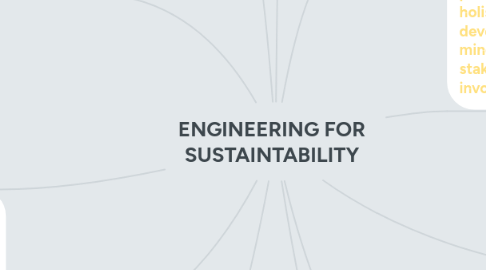ENGINEERING FOR SUSTAINTABILITY
by Carla Galicia

1. SYSTEM THINKING A system is a set of interacting units with relationships among them; this implies that concentrated on the human behavior, the understanding of the drivers of environ- mental awareness gives insight in the conflicting drivers which prevent sustainable behavior.
1.1. Practical applications of system thinking lead to criteria for making a sustainable design.
2. INDUSTRIAL ECOLOGY Can be seen as the scientific part of sustainability as it studies the metabolism of industry, as a part of ecology, and in terms and in line with ecology.
2.1. Ecological systems provide many insights and tools to analyze industry, such as metabolism, but also emphasize the many relationships between elements of the system.
2.1.1. The knowledge provided by the analysis of IE will be of help to obtain a full description of the context of the design and make a proper assess- ment of the design result.
2.1.2. An important objective of IE is to under- stand by modeling these interrelationships and to research how to minimize waste and improve material and energy usage.
3. TRIPLE P • “People”, the social consequences of its actions • “Planet”, the ecological consequences • “Profit”, the economic profitability of companies (being the source of “Prosperity”)
3.1. The Triple P, People, Planet, and Profit or Prosperity requirements are providing a well working metaphor for the set of social, ecological and economic constraints for a sustainable design
4. GOAL DESIGN The goal of the new design should be clear to the designer. In general, the goal of the design is a simple statement (and all other requirements are stated as constraints).
5. CHALLENGES FOR THE ENGINEER Inspiring leaders and movements show vistas to new processes and products.
5.1. Apart from what is the responsibility, what are norms in society, and ethical considerations, the challenge to apply sustainable business chal- lenges to the design can be very stimulating
6. Usually interpreted as sustaining the current state of welfare, closely related to environment: resources depletion, waste handling, recycling, and preservation of biodiversity
6.1. Sustainable development is development that meets the needs of the present without compromising the ability of future generations to meet their own needs.
7. “Sustainability in the end is a means of conducting environmentally sound economic activity for socially desirable outcomes”
7.1. Without compromising usual design criteria such as costs, appearance and quality, all environmental impacts of a design outcome throughout the complete life cycle should be taken into consideration, including social and economic well-being, such as ethics and the environment
8. The sustainable designing process is different because a holistic sustainable development view is kept in mind in all design steps and stakeholders are actively involved.
8.1. The breakdown of the innovation path from idea into stages, the first measure, uses gates in between the stages where a decision is taken to stop the project or to go to the next stage.
9. A product innovation company for instance may want to insert an extra stage in the front end to focus first on linking local market needs with product functions.
10. Radical innovations contributing to sustainable development often means innovations across company fences.
10.1. his means that in the inno- vation more than one company is involved. The radical innovation may also require competences found in institutes and universities
11. In a sustainable conceptual innovation, the design has to be commu- nicated to various stakeholders. This means that the design should be represented in a clear and understandable way.


